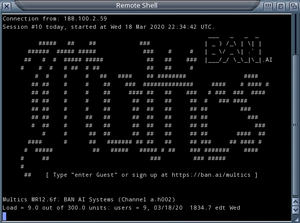
Back مولتكس Arabic Multics AST Multics BAR Multics BS Multics Catalan Multics Czech Multics Danish Multics German Multics Spanish Multics Basque
 | |
 Login screen for the BAN.AI public Multics server | |
| Developer | MIT, GE, Honeywell, Bell Labs |
|---|---|
| Written in | PL/I, Assembly language[1] |
| Working state | Mature, current, historic, emulator available |
| Source model | Open source |
| Initial release | 1969 |
| Latest release | 12.8 / August 10, 2023 |
| Repository | |
| Available in | English |
| Platforms | GE-645, Honeywell 6000 series machines (Honeywell 6180, Series-60/Level-68, DPS-8/M mainframes) |
| Kernel type | Monolithic kernel |
| Influenced | Unix, GEORGE 3, ICL VME, PRIMOS, Domain/OS, Stratus VOS |
| Default user interface | Command-line interface |
| License | Originally proprietary, Free software Multics License since 2007[2][3] |
| Preceded by | Compatible Time-Sharing System |
| Official website | multics-wiki |
Multics ("MULTiplexed Information and Computing Service") is an influential early time-sharing operating system based on the concept of a single-level memory.[4][5] Nathan Gregory writes that Multics "has influenced all modern operating systems since, from microcomputers to mainframes."[6]
Initial planning and development for Multics started in 1964, in Cambridge, Massachusetts. Originally it was a cooperative project led by MIT (Project MAC with Fernando Corbató) along with General Electric and Bell Labs. It was developed on the GE 645 computer, which was specially designed for it; the first one was delivered to MIT in January 1967. GE offered their earlier 635 systems with the Dartmouth Time-Sharing System which they called "Mark I" and intended to offer the 645 with Multics as a larger successor. Bell withdrew from the project in 1969 as it became clear it would not deliver a working system in the short term. Shortly thereafter, GE decided to exit the computer industry entirely and sold the division to Honeywell in 1970. Honeywell offered Multics commercially, but with limited success.
Multics has numerous features intended to ensure high availability so that it would support a computing utility similar to the telephone and electricity utilities. Modular hardware structure and software architecture are used to achieve this. The system can grow in size by simply adding more of the appropriate resource, be it computing power, main memory, or disk storage. Separate access control lists on every file provide flexible information sharing, but complete privacy when needed. Multics has a number of standard mechanisms to allow engineers to analyze the performance of the system, as well as a number of adaptive performance optimization mechanisms.
Due to its many novel and valuable ideas, Multics has had a significant influence on computer science despite its faults.[7] Its most lasting effect on the computer industry was to inspire the creation of Unix, which carried forward many Multics features, but was able to run on less-expensive hardware. Unix was developed at Bell to allow their Multics team to continue their research using smaller machines, first a PDP-7 and ultimately the PDP-11.
- ^ Cite error: The named reference
Mpl1was invoked but never defined (see the help page). - ^ "Multics License (Multics) - Open Source Initiative". opensource.org. February 5, 2008. Retrieved April 11, 2018.
- ^ "Myths about Multics". www.multicians.org. Retrieved April 11, 2018.
- ^ Dennis M. Ritchie, "The Evolution of the Unix Time-sharing System", Communications of the ACM, Vol. 17, 1984, pp. 365-375.
- ^ Dan Murphy (1996) [1989]. "Origins and Development of TOPS-20".
- ^ Gregory, Nathan (May 2018). The Tym Before. Lulu.com. p. 66. ISBN 9781387824755. Retrieved March 29, 2020.
- ^ "Myths about Multics". www.multicians.org. Retrieved April 11, 2018.